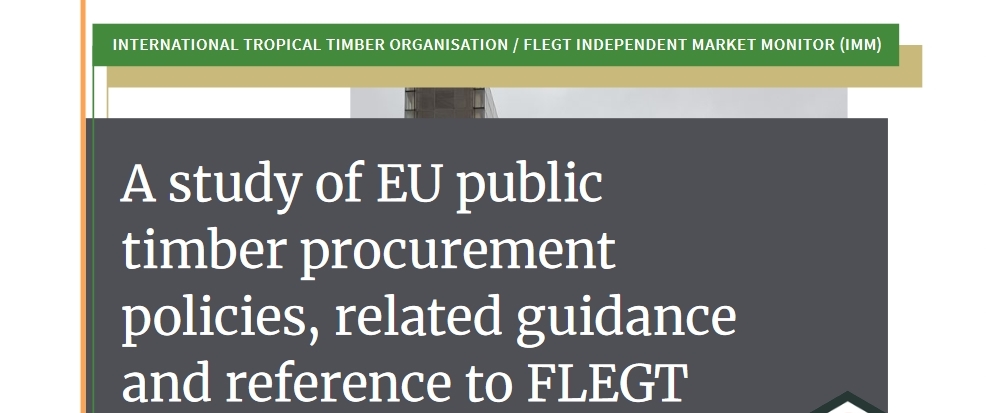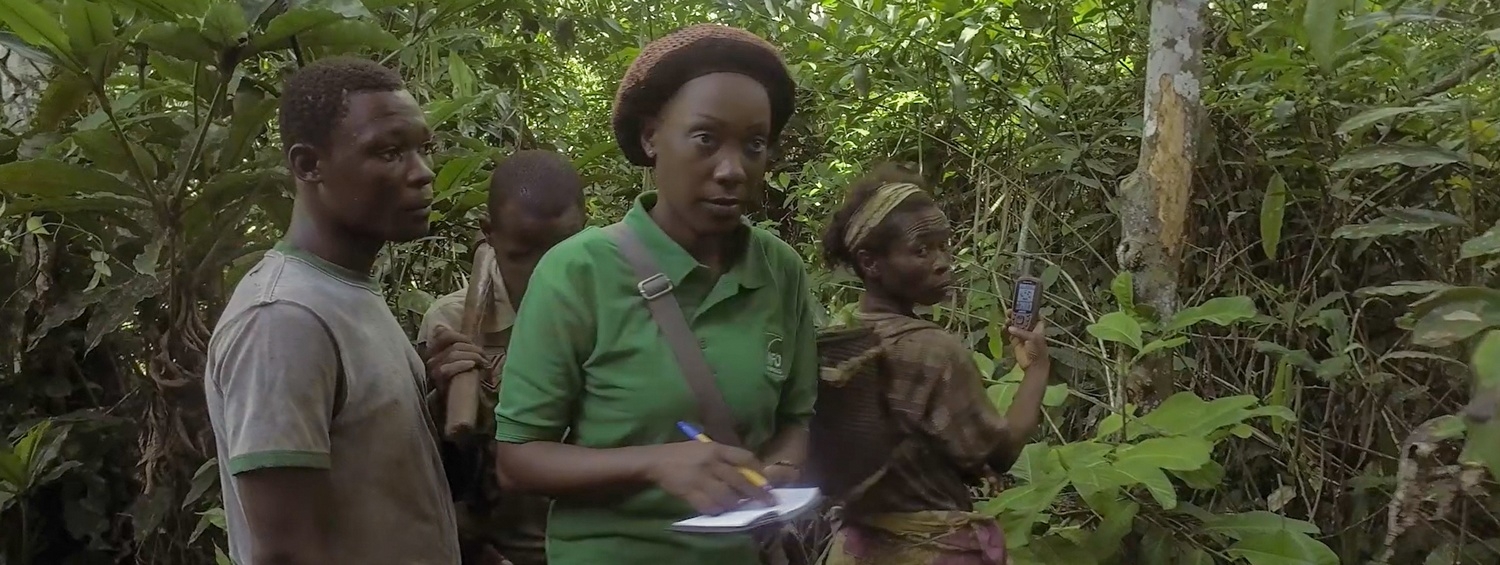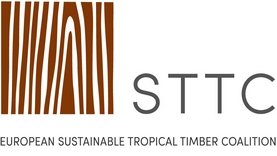Ökobilanzen Nützlich für die Laubholzwirtschaft

Holz-Zentralblatt | Freitag, 6 Dezember 2019 | nummer 49
Akteure der Laubholzwirtschaft aus Europa und einzelne auch von anderen Kontinenten trafen sich am 20. und 21. November in Berlin zu zwei Konferenzen: zur Europäischen Konferenz der Sustainable Tropical Timber Coalition (STTC) und zur “International Hardwood Conference- IHC”. Es gab Überschneidungen bei Teilnehmern, Referenten und Fragestellungen. Eines der durchgehenden Themen war die bessere Positionierung der Branche und ihrer Produkte. In der Öffentlichkeit beobachtet die Branche gegenüber sich selbst und gegenüber Laubholzprodukten viel Unwissenheit, Unsicherheit, Skepsis und teilweise auch Ablehnung. Gleichzeitig hält die Branche jedoch ihr eigenes Tun und ihre Produkte für vorbildlich.
Unlocking Sustainable Tropical Timber Market Growth Through Data

Between 25% and 32% of the primary tropical timber imported into the EU28 was exposed to sustainable timber certification, reveals the latest Probos and GTF Tropical Timber Market Data report. There exist great room for improvement and this number demands decisive action by all stakeholders.
The seven main importing countries (Belgium, France, The Netherlands, Italy, United Kingdom, Germany and Spain) together represent approximately 90% of the EU28 primary tropical timber product import. The concentration of imports in these seven countries provides a strong lever for change. A rapid shift towards sustainable timber could have wide-ranging consequences for the world’s tropical forests.
If the EU28 sourced 100% verified sustainable, it could positively impact an additional 11.7 to 13.4 million hectares of tropical forest. Based on the assumption that certification will prevent premature re-entry logging in the areas it covers, the EU trade in certified tropical timber has the potential to mitigate 55 to 88 million metric tons CO2 a year.
In order to achieve the above impacts and beyond, NGOs, governments, and the private sector in EU timber importing countries not only need to commit to 100% sourcing of verified sustainable tropical timber but also promote the use of sustainable tropical timber as a material, and encourage market growth. We ask civil society and knowledge institutions to support countering the narrative that all timber is not sustainable and to encourage countries with low sustainable sourcing rates to prioritize sustainability. European governments must address sustainable tropical timber in their procurement policies and enhance EUTR enforcement. And all of Europe must continue to work in partnership with key supplier countries and increase international cooperation with other emerging economies. The private sector must drive increases in demand. Buyers must increase purchases, promote sustainable timber to customers, and ensure that the benefits and sustainability of products that bear labels like FSC and PEFC are communicated. All stakeholders’ contributions and collaboration are necessary to generate quality monitoring information – greater industry involvement and transparency will allow to develop powerful and specific solutions to growing sustainable tropical timber imports.
It is only through intensified European ambitions and joint public-private actions that we will have the chance to protect and restore tropical forests. Thus, in line with the release of the latest EU Communication (2019) on Stepping up EU Action to Protect and Restore the World’s Forests, we urge the top importing and consuming countries in EU to recommit to 100% sustainable tropical timber.
Green supply chain network launches at Shanghai Forum

The creation of an international, pan-industry coalition to enhance forests’ multiple values and drive forest and timber sector legality and sustainability was agreed at the recent forum, Together Towards Global Green Supply Chains. Another outcome of the Shanghai meeting was a cooperative agreement between organisations representing Asian and European businesses active in the Gabon forest sector.
The forum drew a 350-strong audience from around the world, including major operations in the tropical timber products industry and trade. It was co-organised by the International Tropical Timber Organisation (ITTO), China Timber and Wood Products Distribution Association (CTWPDA), the International Tropical Timber Technical Association (ATIBT), and China’s Center for International Forest Products Trade/National Forestry and Grassland Administration (CINFT/NFGA).
Speakers said the world is facing unparalleled environmental risks and challenges. Forests were both threatened by climate change and wider environmental degradation, and at the same time held potential solutions for both. They needed protection and the forestry and timber sectors could be key to delivering it.
“Forests, especially tropical forests, contain extraordinary biodiversity, are crucial for climate-change mitigation, and have huge cultural importance,” said John Leigh, Chair of the ITTO. “Yet the land they occupy is also valuable for farming, mining and urban development. To minimize the risk of losing forests, it’s imperative they generate economic benefits for development, income, jobs, and livelihoods. This is why we need green supply chains to ensure stable supplies of legal, sustainable timber from sustainably managed forests.”
The new coalition, the Global Green Supply Chains Network, is open to forest companies and other timber sector stakeholders in producer and consumer countries. It pledges to ‘promote sustainable development of forest industries and contribute to the conservation and sustainable use of global forest resources’.
The network is open to others along the supply chain to join, through to consumers. It will promote exchange and business and technical cooperation across forestry and timber sectors. The Shanghai Forum organisers also committed to back it, with ITTO bringing the support of its Legal and Sustainable Supply Chains Programme.
“The development of global green supply chains will enhance the production, processing, distribution and consumption of legal and sustainable timber and forest products, including tropical timber,” said ATIBT president Robert Hunink. “It will bring benefits to all stakeholders and help solve some of the world’s most urgent problems.”
“The industry faces many challenges in global adoption of green wood supply chains,” said Zhu Guangquan, Chief Expert of CTWPDA. “It requires a spirit of partnership throughout the industry.”
Next steps in development of the network will be sharing experiences of the existing Global Green Supply Chain (GGSC) platform in China and creation of an open access information database incorporating the Global Timber Tracking Network (GTTN). Participants will also support inter-business communication and exchange, with monthly publication of GGSC Network updates and timber and wood products market data. In addition, an entrepreneurs and private-sector expert team will be formed to feed in its views.
“From ITTO’s perspective, the significance of the new Network will be determined by how successfully it is managed, while it is aimed to attract stakeholders who are committed to being part of legal and sustainable supply chains (LSSC),” said ITTO Director Operations Sheam Satkuru. “The participation and support from a select group of the Chinese forestry and wood products sector can be seen as catalytic towards establishing legal and sustainable supply chains and the network is foreseen to expand to several regions globally.”
Also in Shanghai, the Union of Forest Industries and Managers of Gabon (UFIGA) and the Union of Asian Forest Industries of Gabon (UFIAG) agreed to extend their cooperation in support of the GGSC Initiative. All Gabonese forest industries committed to work towards independent third party certification of legality and/or sustainability over the next three years. “This is crucial to achieve a much needed level playing field, and at the same time to improve the image of our industry,” said Mr Hunink. “ATIBT will try to convince governments and federations in other Congo Basin countries to follow suit.”
“ATIBT and the CTWPDA also signed an agreement in Huzhou, China, [venue for the CTWPDA wood flooring and hardwood conference, following the Shanghai meeting] to intensify exchanges on sustainable management and responsible supply chains,” said ATIBT Managing Director Benoît Jobbé-Duval, adding that his organisation will also work closely with the GGSC Secretariat in China.
Sustainable tropical timber – a shared goal

New speakers have been announced for the STTC 2019 Conference, Exploring pathways to sustainable tropical timber. The November 20 event in Berlin also looks like attracting a capacity audience, with over a 100 registrations from across Europe and timber supplier countries.
Latest confirmed speakers include Jesse Kuijper of the Borneo Initiative who will look at impacts of certification on landscapes and David Hopkins, Managing Director of the Timber Trade Federation, who will examine common ground between the EUTR, FLEGT and certification.
Rui Pedro de Almeida Ribeiro and Priscyla Rocha Silva, consultants working on a Verified Sourcing Area project in Mato Grosso, Brazil, will take part in round-table dialogues with delegates, and Benoît Jobbé-Duval of the International Tropical Timber Technical Association (ATIBT), Stefan Meinhardt of tropical timber specialist Hupkes, Christophe Janssen of Interholco and Ingrid Hontis of Belgian textile, wood and furniture federation Fedustria, will participate in a panel discussion on tackling Europe’s declining use of tropical timber.
At the time of publication, 120 delegates had registered for the Conference, which means it is nearly fully booked.
The theme of the day is how verified sustainable forest management can build on regional and national initiatives, such as the EU FLEGT VPA programme and Verified Sourcing Areas, to help achieve a common goal – a legal, sustainable and commercially viable tropical timber market for the long-term. It will also address the part PR and Communication tools and data can play the process.
Under the theme Navigating the journey from EUTR through to verified sustainable, Mark van Benthem of Probos will present findings of a new study, undertaken with the Global Timber Forum, on EU 28 verified sustainable tropical timber market share. IDH Programme Manager Nienke Sleurink will also address what the timber sector can learn from use of Verified Sourcing Areas in the Brazilian beef sector.
Wilhelm Unnerstall for the host city of Berlin, itself an STTC member, will describe how it promotes tropical timber use through its procurement policy and Eric de Munck, of the Netherlands Timber Trade Association (NTTA), will look at how timber trade federations can act as catalysts for industry-wide cooperation to grow the sustainable tropical timber market.
The Conference keynote will be delivered by Reinier van den Berg of meteorological services operation MeteoGroup; his theme, the importance of sustainably managed forests and use of verified sustainable timber in meeting the Paris Climate Agreement.
In common with previous STTC Conferences, a central focus of the Berlin event will be delegate participation. There will be round table discussions in both the morning and afternoon, where participants can address issues raised by speakers, ask questions, and share experience and new ideas on sustainable tropical timber promotion and market growth. Among other discussion leaders will be Nele Schmitz of the Thunen Institute, Ben Romein of FSC Netherlands, George White of the Global Timber Forum and Indra van Gisbergen of FERN.
The STTC Conference takes place at Berlin’s Hotel Amano Central the day before the International Hardwood Conference at the same venue, enabling delegates to attend both.
For more information and to register go to the STTC website.
Gabon incentivized to save forests and cut emissions

Photo JB Dodane
Gabon is set to receive $150 million over ten years for cutting emissions from forest degradation and deforestation and for the CO2 sequestration of its natural forests. The deal, under the UN REDD+ programme, was brokered with the country by the Central African Forest Initiative (CAFI) on behalf of funder Norway. It was announced by Gabonese Forests Minister Lee White at the Climate Action Summit at the UN in September.
The initiative, which will be subject to third party verification, sets a carbon floor price of $10 per certified ton to incentivize forest maintenance and emissions reduction. Payments will also be retrospective, covering Gabon’s achievement in this area going back to 2016.
“We have to raise the value of Gabonese rainforests to ensure conservation and sustainable exploitation can be used as tools to improve living standards by creating jobs and livelihoods, whilst also sustaining natural capital,” said Mr White. “Norway’s agreement to double the price of a ton of rainforest carbon dioxide is highly significant and gives us hope that the international community will move towards a realistic price that will provide a real incentive for rainforest countries to follow our example.”
Norway Minister of Climate and Environment Ola Elvestuen described the project as ‘historic’. “It properly takes into account Gabon’s special status as a country with high forest cover and low deforestation,” he said. “It is 88% covered with forests, and I hope our partnership can help them reach their goal to maintain 98% of that for the future.”
According to CAFI, Central African forests and peatlands store up to 70 billion tons of carbon, equivalent to 5-10 years’ global greenhouse gas emissions. Emmanuel Groutel expert in strategy and international markets at WALE welcomed the Gabonese initiative and said it could be a model for fellow supplier states. “The whole world must support Gabon because what it is proposed is an example of virtuous development that preserves the environment and shows the way forward for other countries in the region,” he said.
ATIBT President Robert Hunink applauded the Gabon initiative. “I hope that other Congo Basin countries consider following this example. It would truly be a great contribution towards climate change mitigation,” he said. “However, in other to convince governments that forest conservation could be an alternative income model to conventional harvesting, carbon prices need to reflect this. And last but not least, socio-economic development should not be negatively impacted by these agreements.”
In 2018, Gabon President Ali Bongo Ondimba stated that all forest concessions in the country must be certified by 2022.
EU governments take diverse approach on timber procurement

A study on the emphasis on legality and sustainability verification in EU member state public timber procurement policies highlights that sustainability certification is what most require of suppliers. At the same time, it emphasizes the wide diversity of approaches in this area.
The report has been produced by the EU FLEGT Independent Market Monitor (IMM). Its role is to monitor trade flows from supplier countries engaged in the EU FLEGT Voluntary Partnership Agreement legality assurance initiative and market impacts of FLEGT-licensed timber. It also gauges EU market perceptions of the FLEGT programme.
The particular focus of the report, titled A study of EU public timber procurement policies, related guidance and reference to FLEGT, is where FLEGT sits in policies, notably relative to sustainability certification.
Public procurement, it states, is not only a key factor in the timber marketplace due to the wood volumes government itself buys, but also because of its influence on private procurement. “Sustainable procurement is therefore about using public spending to achieve social and environmental objectives, and to strategically use the public sector’s economic power to catalyse innovation in the private sector,” it says.
The report underlines that some EU governments still don’t have a specific timber policy.
Those that do, differ in what they accept as evidence of sustainability and legality. Some are mandatory, others voluntary. There is also variation in their application to different levels of government. Most EU national governments have mandatory purchasing policies for central government departments, but voluntary for local authorities and other agencies, which are actually responsible for most public spending.
“Most EU governments also do not know how much wood they purchase, so have no indication how much sustainable, legal or FLEGT-licensed material is included,” states the report.
In total, 22 member state governments have a timber procurement policy. Of the other six, Portugal and Poland are addressing the topic, but Greece, Estonia, Hungary and Romania have no declared plans for policy development.
All 22 governments with policies accept third party certification, i.e. FSC and PEFC, as proof of legality and sustainability. Eighteen mention FLEGT licenses, while 12 cite third party legality verification, self-declaration and ecolabels. Of the 18 that mention FLEGT licences, only the UK and Luxembourg accept them on an equal basis with third party certification as proof of legality and sustainability. Others accept them as evidence of legality and sustainability, but secondary to certification, or as proof of legality only.
The report finds that there is little government reporting of compliance with their own procurement policies. Belgium has however addressed impact of its policy. A 2017 study of 140,000 tender documents found 1,800 mentions of FSC or PEFC in tender documents. FSC was specified in 88 contract notifications, PEFC in one, while FLEGT Licences were not specified at all.
The full IMM public procurement report can be downloaded here. For its earlier report on private sector procurement policies click here.
Award-winning film shows forest management supporting biodiversity

A documentary featuring STTC and Fair & Precious partner Interholco, which highlights how sustainable forest management in the Republic of Congo can incentivise forest and habitat conservation has won Germany’s prestigious Nature Film Prize.
In ‘Paradise Preserved: Congo – Protecting the Gorilla Forests’ , which was produced by Thomas Weidenbach for tv channel ARTE, film-makers followed the work of forest and industry teams from Interholco subsidiary IFO in the Republic of Congo over several weeks.
The company manages an FSC concession of 1.16 million ha in the country and the film showed how its approach to sustainable management, including working with conservation organisations, helps preserve habitats, in this case home to several thousand western lowland gorillas.
“The jury came to its decision based on the film’s positive vision of how it’s possible to secure nature in the tropical forest, while at the same time providing local people with long-term, economic prospects,” said Interholco managing director Ulrich Grauert. “’Made in Africa’ sustainable hardwood offers a multitude of solutions to help tackle climate change, while supporting social justice in developing countries and protecting habitats. We hope this film will be shown in schools all over Europe. It explains in a comprehensible way how sustainable forestry works in Africa.”
In its report on the award, newspaper Süddeutsche Zeitung said the documentary demonstrates ‘how it is possible to give nature a value that ultimately contributes to its protection’.
“This is a previously neglected perspective, which gives hope in nature conservation and social terms,” it said.
Streaming service Curiosity Stream (www.curiositystream.com) shows the film with the strapline: ‘Something exceptional is happening in the north of the Republic of the Congo. Here loggers are not destroying the environment, but helping preserve the tropical forests’.
The German Nature Film Foundation has been awarding its annual prize since 2008. The aim is to support the work of film makers, but also help conservation by ‘bringing endangered species and natural spaces’ into people’s living rooms’.
The award was presented by German culture minister Bettina Martin.
You can watch the film here: https://curiositystream.com/video/3159.
Civil engineering projects highlight tropical timber performance

Two major new infrastructure projects in the Netherlands demonstrate the technical potential and carbon benefits of tropical timber in marine civil engineering.
In Zeewolde harbour, a series of six giant lock gates have been installed, all in FSC-certified azobé.
In total, the gates comprise 74m3 of timber, with the largest 4m wide and 10m high. They were designed and produced by hardwood specialists Wijma Kampen and assembled in association with Machinefabriek Rusthoven. Despite their size, the first four, precisely machined to size, were installed in just two days. The final two were due to be in place in August.
The second project, completed earlier this year, is a 149m footbridge in the Afferdense, Deeste Waarden area. Planning for the structure, which bridges a side channel, started in 2008 with the aim of opening up new walking routes in the area.
Azobé was once more the timber specified, a total of 75m3, storing 122.6 tons of CO2. The 100% FSC-certified material was supplied by Boogaerdt Wood.
Both projects are featured on the website of the Hout in de GWW initiative (www.houtindegww.nl), an alliance of 12 timber providers and timber research and market development organisation Centrum Hout. The aim is to promote use of verified sustainable hardwood in the civil and marine civil engineering sectors.
The campaign targets construction professionals and specifiers such as municipal and regional authorities, and waterway management bodies and supports life cycle analysis and other research and testing to demonstrate the properties of hardwood.
“We believe we’ve put tropical timber, as an environmentally friendly and suitable technical solution, back to ’top of mind’ with professionals and other decision makers in this sector,” said Centrum Hout’s Eric de Munck. “Another spin off is that the Dutch Ministry of Transport and Waterways has started a consultation on the possibilities of using more timber in infrastructure projects to accelerate its progress towards CO2 reduction and climate impact reduction goals. It has also commissioned its own LCA studies to strengthen the business case for wood.”
At the Berlin STTC Conference, Eric de Munck will share more details about the Hout in de GWW initiative.
STTC site develops as sustainable tropical timber hub

The Sustainable Tropical Timber Coalition has relaunched its website, www.europeansttc.com, developing its role as an information hub on sustainable timber procurement and the benefits it delivers in underpinning sustainable tropical forest management.
The revised STTC site sets out its objectives to increase EU demand for verified sustainable tropical timber through communicating its technical and environmental benefits, and the environmental and development value of tropical forests. Its goal is also to convince tropical suppliers that there is a long-term viable market for verified sustainable tropical timber, so incentivizing uptake of sustainable forest management.
The website’s Market Data page highlights the STTC’s view that accurate, consistent data on the tropical timber trade is central to informing EU market development. It details its own market reports and analysis. It also provides links to other international and national data sources.
In its Marketing section, the website underlines the importance of stepping up tropical timber communication and promotion in the EU given its perception that it is implicated in deforestation. Key tropical timber marketing resources and tools are listed and linked. These include life cycle analysis studies on tropical timber, manuals on the use of certified timber in construction, and the STTC’s YouTube channel, which features a range of videos on the STTC itself, its partners, and the wider values of sourcing verified sustainable tropical timber. It also links to other sustainable tropical timber marketing initiatives and information resources and websites on the performance and availability of lesser used tropical timber species, relevant regulation and business information.
The site also includes a dedicated page on lesser used tropical species (LUS) which, the STTC says, if used more widely would reduce stress on more popular varieties and make sustainable forest management more economically viable. It links to a number of websites focused on availability and technical performance of LUS and a range of other resources focused on varieties from Africa, South East Asia and Latin America. It lists sources of guidance on marketing LUS and their performance in specific applications.
The Procurement Policies page details how these shape the marketplace for tropical timber and provides a link to the Buying Sustainable Timber Guide for public authorities. The STTC is looking to update and include on the website a database providing guidance, materials, tools and training resources for public authorities on sustainable timber product procurement.
The STTC website additionally features a section on the impacts of using verified sustainable tropical timber in terms of climate change mitigation, the superior life cycle performance of timber products and forest and biodiversity maintenance. It also provides a comprehensive list of resources on the wider social, economic and environmental benefits of sustainable forest management.
“Using verified sustainable tropical timber from sustainably managed forests has numerous, often interrelated benefits,” states the STTC. “These are also increasingly objectively proven and documented.”
The site features also prominently a link to the website of the sustainable tropical timber branding campaign Fair&Precious. The two initiatives earlier this year announced that they would work closely together to achieve their shared aim of growing the EU market for verified sustainable tropical timber. Each committed to leverage the strengths of the other, with the STTC’s focus on market and product data and analysis, Fair & Precious’s emphasis on marketing the environmental, social and economic benefits of sourcing tropical timber from sustainably managed forests.
The STTC will continue to develop the website and welcomes feedback and contributions with regards to resources (promotional tools, data resources, publications, etc.).


